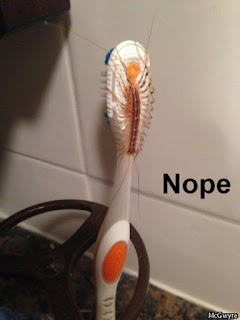The creature above is called a house centipede (Scutigera coleoptrata) and it Freaks. People. Out. Why? Well let's start with its appearance. It has 15 long pairs of thin, wiggly legs, and on females, the last pair are longer than the body. Combine those legs with fast zig-zag movements, and you've got a recipe for nightmares.
But house centipedes don't have to be a source of stress, they can be something rather interesting and even beneficial! Let's take those things that creep you out and put a new spin on them, shall we?
1. Leeeeegs! So many leeeeeegs!
It's true, house centipedes do have quite a few legs, 15 pairs in fact. But when they first hatch as wee babies, they only have 4 pairs of legs. Yup, they're born pretending to be arachnids with those 8 legs of theirs. As house centipedes grow, they gain more legs each time they shed their skin. They go from 4 pairs to 5, then 7 pairs, then 9, 11, 13, and finally 15 legs once fully grown. Each time the house centipede grows, it only has more legs to hug you with.
House centipedes have the ability to break off some of their legs when caught by a predator, which then keep wiggling on the ground to serve as a distraction. This is the same strategy employed by many lizard species, which can break off their tails in response to predators.
2. They run so fast, it creeps me out!
They do run fast, and when you look at the numbers, it should make you marvel instead of cower. These guys can clock in at 1.3 feet per second! Now let's take that into consideration of the house centipede's body size, which is between 1 to 1.5 inches. This means the house centipede can run a distance 12 times its body length in just over one second. If my 5'3" self were crawling on the ground, it would be the equivalent of skittering 63 feet in the same amount of time. Why do they have to run so fast? That's a nice transition into #3...
3. What are they even doing in my house?
House centipedes, like their other centipede relatives, are predators. No, don't worry, you or any part of you are not on the menu.
These centipedes eat silverfish, spiders, bed bugs, termites, and cockroaches. These guys are like a live-in Orkin man, an Orkin man that needs a jacket with 30 sleeves. This is why house centipedes have such amazing speed, to catch quick invertebrates they have to be even faster.
4. Get them out! Get them out!
Ok, so maybe even after reading these cool facts about house centipedes you still don't want them in your house. How do you go about getting rid of them?
This might not be a good idea.
If you remember in factoid #3 up there, the house centipede is in your house because it has found a reliable source of food. Get rid of the food, and the predator will move on. Try to find the places where insects and other invertebrates are getting into your house. Do you have cracks in your foundation or walls? Holes or gaps in your window screens? These home fixes will not only reduce the amount of unwelcome house guests, but are probably good ideas to do for preventative house maintenance anyway.
If nothing else in this blog entry about house centipedes gives you any relief, consider this: at least the house centipedes running around in your house aren't as big as this cave-dwelling relative from China.
You're welcome.






House centipede love! <3 <3 <3
ReplyDeleteKill it!!!!
ReplyDeleteNice page. They're the coolest. I wish people weren't so ignorant...
ReplyDeleteThey're great, outside 😅
ReplyDelete